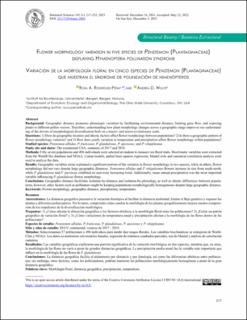Flower morphology variation in five species of Penstemon (Plantaginaceae) displaying Hymenoptera pollination syndrome
Journal article, Peer reviewed
Published version

Åpne
Permanent lenke
https://hdl.handle.net/11250/3112427Utgivelsesdato
2023Metadata
Vis full innførselSamlinger
- Department of Biological Sciences [2232]
- Registrations from Cristin [9766]
Originalversjon
Boletín de la Sociedad Botánica de México. 2023, 101 (1), 217-232. 10.17129/botsci.3084Sammendrag
Background: Geographic distance promotes phenotypic variation by facilitating environmental distance, limiting gene flow, and exposing plants to different pollen vectors. Therefore, understanding how plant morphology changes across a geographic range improves our understanding of the drivers of morphological diversification both on a macro- and micro-evolutionary scale.
Questions: 1) How do geographic location and abiotic factors affect flower morphology between populations? 2) Is there a geographic pattern of flower morphology variation? and 3) How does yearly variation in temperature and precipitation affect flower morphology within populations?
Studied species: Penstemon albidus, P. fruticosus, P. glandulosus, P. speciosus, and P. whippleanus
Study site and dates: The continental USA, summers of 2017 and 2018
Methods: Fifty-seven populations and 496 individuals were selected at random to measure ten floral traits. Bioclimatic variables were extracted from the WorldClim database and NOAA. Linear models, partial least squares regression, Mantel tests and canonical correlation analysis were used to analyze the data.
Results: Geographic variables alone explained a significant portion of the variation in flower morphology in two species, while in others, flower morphology did not vary despite large geographic distances. Penstemon albidus and P. whippleanus flowers increase in size from south-north, while P. glandulosus and P. speciosus exhibited an east-west increasing trend. Additionally, mean annual precipitation was the most important variable influencing P. glandulosusflower morphology.
Conclusions: Geographic distance facilitates isolation-by-distance and isolation-by-phenology as well as abiotic differences between populations; however, other factors such as pollinators might be keeping populations morphologically homogeneous despite large geographic distance.
